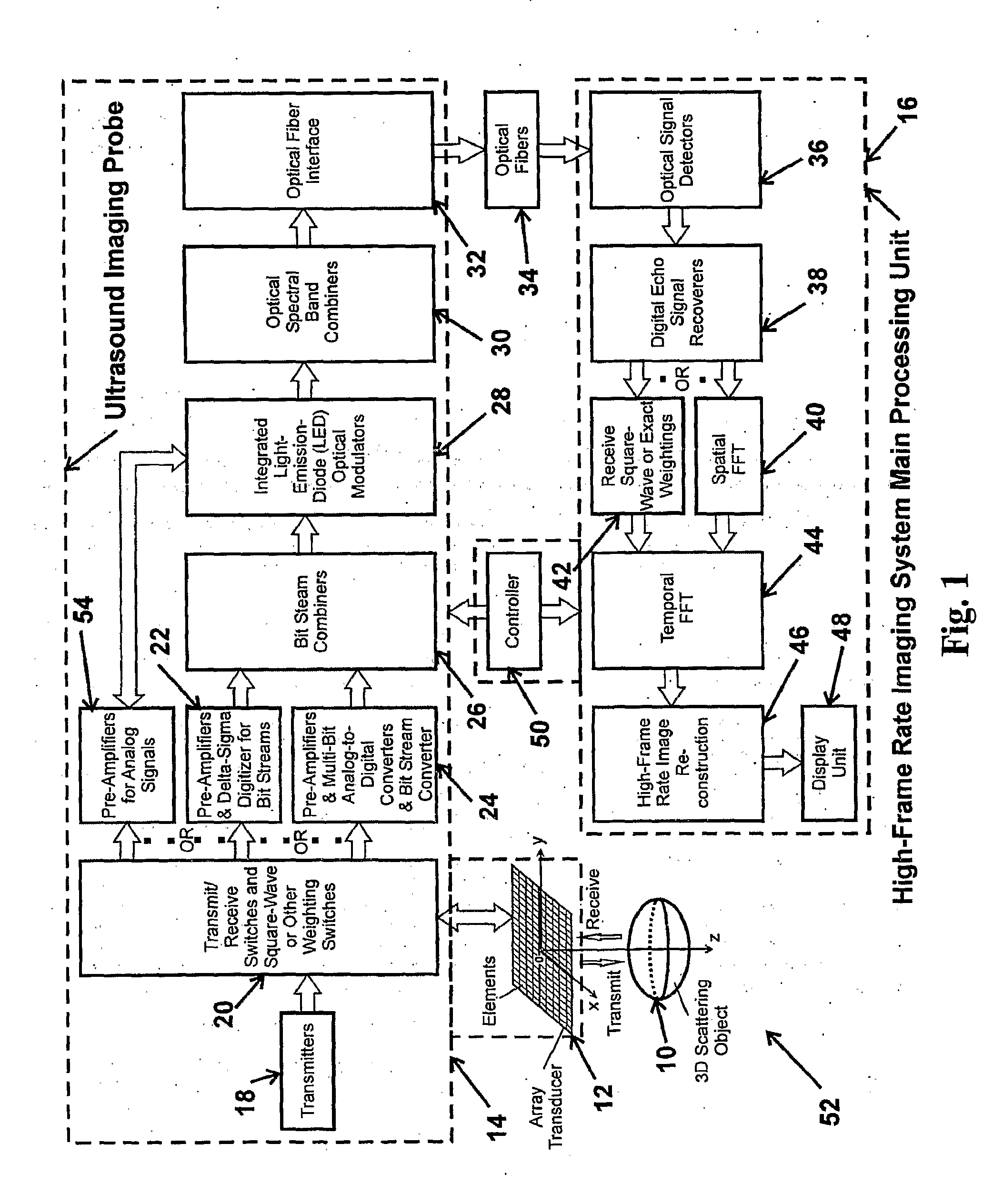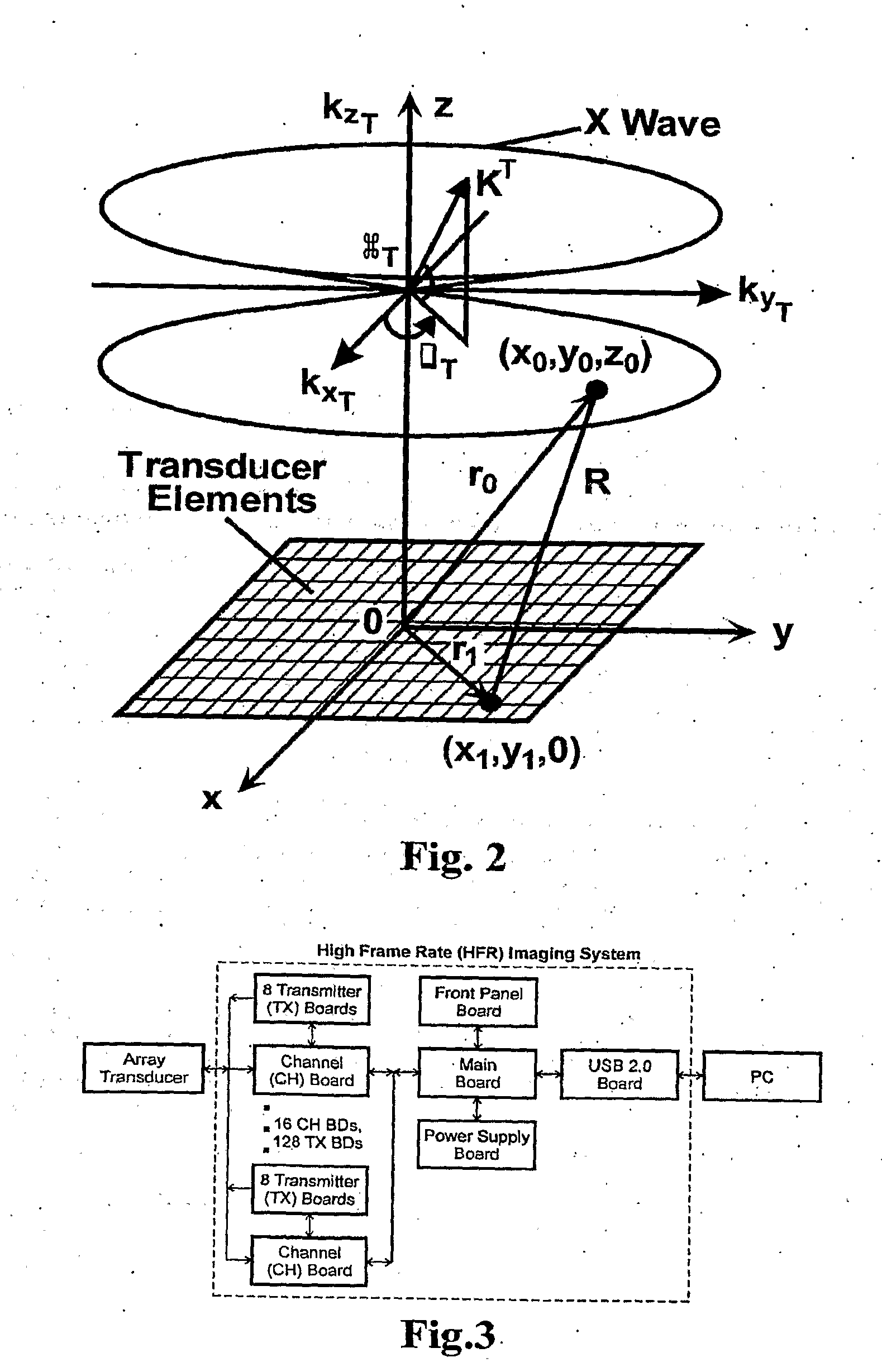[0010]In one aspect, there is provided a system for producing a high frame rate, high resolution and high contrast image The system generally can include: a) transmitting a group of signals of energy toward one or more objects to be imaged, the signals being weighted spatially on one or more transmitting apertures i) by square waves, or ii) by limited-diffraction beans; b) weighting or Fourier transforming receive signals spatially on one or more receiving apertures; c) reconstructing a two- or three-dimensional image data set from i) the transmitted signals, and, ii) the receive signals; and, d) reconstructing the image from the image data set of step c.
[0011]In another aspect, there is provided a system for producing a high frame rate, high resolution and high contrast velocity vector image of one or more objects where at least a part of one or more objects is moving. The system can generally include: a) transmitting two or more groups of signals of energy toward the one or more objects, the signals being weighted spatially on one or more transmitting apertures i) by square waves, or by limited diffraction beams; b) weighting or Fourier transforming receive signals spatially on one or more receiving apertures; c) reconstructing two- or three-dimensional image data sets from the groups of: i) the transmitted signals, and, ii) the receive signals; and; d) using the image data sets to reconstruct: i) a first set of flow velocity component images in a first direction, and ii) a second set of flow velocity component images in a second direction that is different from the first direction; and, e) reconstructing one or more velocity vectors image from the first and second sets of velocity component images.
[0012]In yet another aspect, there is provided a system for producing a high frame rate, high resolution and high contrast image of one or more objects. The system can be an apparatus that generally includes: 1) one or more devices configured to: a) transmit a group of signals of energy toward the one or more objects, the signals being weighted spatially on one or more transmitting apertures: i) by square-waves, or ii) by limited diffraction beams; and b) receive, and weight or Fourier transform receive signals spatially on one or more receiving apertures; 2) one or more devices configured to reconstruct a two- or three-dimensional image data set from the transmitted signals and the receive signals; and / or 3) one or more devices configured to reconstruct the image from the image data set.
[0013]In another aspect, there is provided a system for producing a high frame rate, high resolution and high contrast image comprising an array transducer probe operatively linked via an optical link to an imaging system. The array transducer probe can include one or more devices configured to transmit a group of signals of energy toward the one or more objects, the signals being weighted spatially on one or more transmitting apertures: i) by square-waves, or ii) by limited diffraction beams.
[0014]In still another aspect, there is provided a high frame rate imaging system comprising a high-speed optical link between an array transducer probe and an image reconstruction system. The optical link can include one or more of the following, alone or in combination: one or more multi-bit analog-to-digital converters or one or more delta-sigma digitizers configured to produce bit streams; one or more bit steam combiners configured to funnel multi-channel data into higher-speed bit steams with fewer channels; one or more light-emission-diodes (LED) or any suitable light-emission devices configured to convert electrical bit streams to optical signals; one or more optical spectral combiners configured to combine multi-channel optical signals; one or more optical fiber interface and fibers; and, one or more light detectors and circuits configured to recover original electrical receive echo data produced by the array transducer probe. The image reconstruction system can be configured to reconstruct multi-dimensional images through square-wave aperture weightings or spatial fast Fourier Transform FFT circuits. The system can further include a device to amplify signals from the array transducer probe.
[0015]In yet another aspect, there is provided a high frame rate imaging system that can include one or more of the following, alone or in combination: a) a device capable of recording radio frequency (RF) data from one or more transducer elements for at least one heart cycle synchronized to an electrocardiogram (ECG)-signal at a desired frame rate determined by ultrasound propagation speeds and system timing overhead; b) at least one independent linear power transmitter and its associated fast transmit / receive (T / R) switch for each transducer element; and, c) a device capable of storing the acquired RF data and transferring the stored data to a computer for one or more of signal processing and image reconstruction.
 Login to View More
Login to View More  Login to View More
Login to View More 


